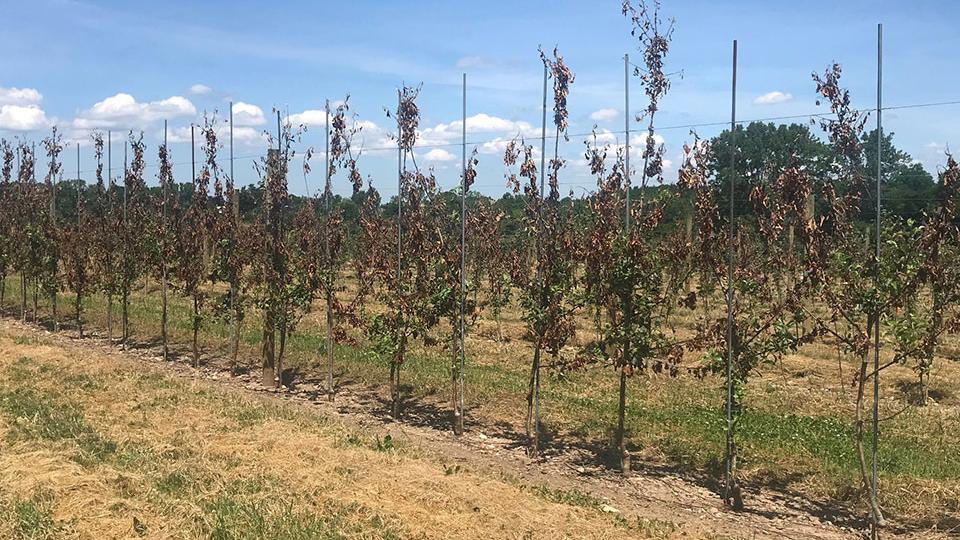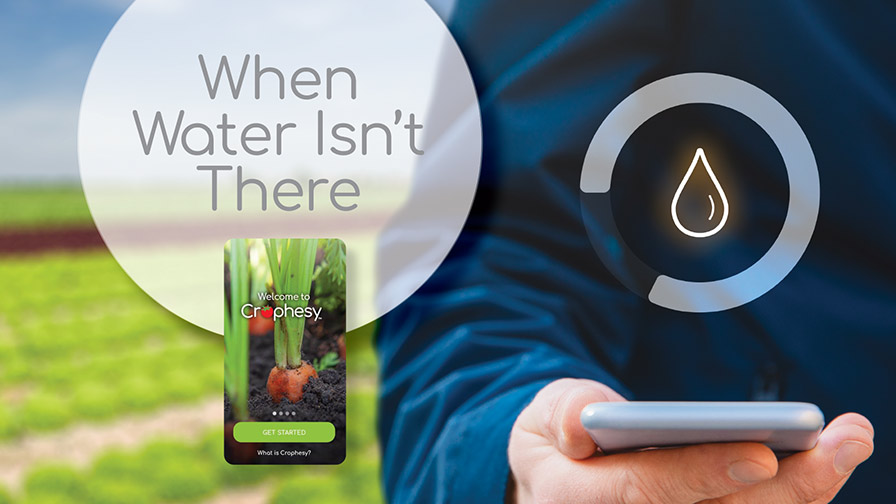Plan To Keep It Cool When Battling Fire Blight

Researcher David Strickland of Cornell Agritech knows all too well the speed at which fire blight disease can strike. This is one of Cornell’s research blocks, where “we let fire blight get away from us.”
Photo by David Strickland
David Strickland can relate. The young Ph.D. candidate at Cornell AgriTech gave a talk at the eighth annual BioSolutionsSM Conference & Expo in Reno, NV several weeks ago, screening slides from a PowerPoint presentation on fire blight. He noted that in the U.S., the vast majority favor varieties that are susceptible to fire blight.
“Even those that are moderately resistant, such as ‘Cosmic Crisp’ and ‘Red Delicious’, if there are ideal conditions — the perfect amount of heat units and the right amount of disease pressure — even those cultivars can crumble as well,” Strickland said. “You apple growers looking at this, you’re probably thinking, ‘Yep, I grow that,’ so fire blight is already on your radar.”
Pouring salt on the wound, he noted the nasty disease costs the industry more than $100 million every year, before changing to a photograph showing an orchard fully engulfed with fire blight that actually looked like some deranged farm worker had scouted with a blow torch.
“That’s one of our research orchards right there, we let fire blight get away from us,” he said. “An orchard can be wiped out in one season if left unchecked.”
Yes, Strickland, who comes from an apple-growing family, can relate. Growers in the audience were listening intently as he said growers sometimes must make trade-offs, including their choice of cultivar(s). If you’ve had persistent problems with fire blight disease and can’t figure any other way to solve it, Strickland advises growing less-susceptible cultivars as one means of strengthening an orchard’s resiliency.
“Everyone wants ‘Honeycrisp’ for a reason,” he says, “but honestly, that’s not always (what you should) go with.”
DON’T PLAN TO FAIL
Choosing less susceptible varieties for an area prone to fire blight should go hand in hand with choosing a fire blight-resistant rootstock such as ones from the Geneva series or Bud 9, Strickland says. Besides the right rootstock and variety, growers should have a good chemical management plan, ideally paired with a Decision Support System (DSS), before the season begins.
Quite simply, a DSS optimizes and reduces inputs for blossom blight management, alerting growers as to when and how favorable the conditions are for blossom blight, he says. It does not predict product control failures, future disease pressure, or shoot blight pressure later in the season (as that’s largely influenced by how much blossom blight escapes management). For conventional growers, DSS use is best practice for avoiding antibiotic resistance as said products are efficiently applied at critical timings in pathogen development.
Strickland says growers will want to construct an application schedule timed to the key phenological stages in tree development and can look to their state’s Extension offices for assistance. A model sample program might look like:
- Pre-Season: Delayed dormant fixed copper apps at silver tip when warm weather causes cankers to ooze.
- Tight Cluster to Pink: Early Prohexadione calcium (PhCa) (6 oz/100 gal) applications to thicken pedicel cell walls and prevent bacterial invasion. Apply defense inducer program at pink.
- Bloom: Use a consultant, Extension alerts, or DSS to identify fire blight infection periods. Most models over-predict infection risk; shouldn’t need >3 apps (antibiotic and/or biological) to petal fall.
- Post-Bloom: PhCa (6-9 oz/100 gal) at petal fall, then 10-14 days later, will slow growth of trees.
- Summer: Protectants to reduce surface bacteria. Use a low-rate copper program on a seven- to 10-day schedule until terminal
bud set.
TAKE CONTROL
Prior to the season, Strickland says it is critical to scout orchards for oozing cankers and remove them if at all possible. If the infection has reached the central leader, the trees should be pulled out.
“For young trees, particularly for new plantings of higher density, if you see the main leader is afflicted, don’t try to rescue the tree, remove and replace,” he says. “It’s better to remove and replace so it doesn’t become a source of inoculum for the following growing seasons.”
Likewise, in the summer and into the post-season, growers should prune out strikes and small cankers to reduce inoculum pressure. “Remove as soon as noticed on a cool, dry day,” he says, “not on those humid, warm days when the bacteria are flowing much more freely through the vasculature.”
The best-laid plans are useless unless acted upon, and fire blight, perhaps more than any disease commonly faced by apple growers, definitely requires a proactive mindset. The disease is just too nimble and destructive; growers should be on a seek-and-destroy mission.
“A fire blight management program is planned out and proactive; you need to stay on top of this disease,” Strickland says, “because if you mess up, it’s gone forever.”









